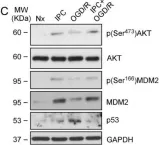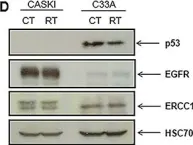One of the most important mechanisms of preconditioning-mediated neuroprotection is the attenuation of cell apoptosis, inducing brain tolerance after a subsequent injurious ischemia. In this context, the antiapoptotic PI3K/AKT signaling pathway plays a key role by regulating cell differentiation and survival. Active AKT is known to increase the expression of murine double minute-2 (MDM2), an E3-ubiquitin ligase that destabilizes p53 to promote the survival of cancer cells. In neurons, we recently showed that the MDM2-p53 interaction is potentiated by pharmacological preconditioning, based on subtoxic stimulation of NMDA glutamate receptor, which prevents ischemia-induced neuronal apoptosis. However, whether this mechanism contributes to the neuronal tolerance during ischemic preconditioning (IPC) is unknown. Here, we show that IPC induced PI3K-mediated phosphorylation of AKT at Ser473, which in turn phosphorylated MDM2 at Ser166. This phosphorylation triggered the nuclear stabilization of MDM2, leading to p53 destabilization, thus preventing neuronal apoptosis upon an ischemic insult. Inhibition of the PI3K/AKT pathway with wortmannin or by AKT silencing induced the accumulation of cytosolic MDM2, abrogating IPC-induced neuroprotection. Thus, IPC enhances the activation of PI3K/AKT signaling pathway and promotes neuronal tolerance by controlling the MDM2-p53 interaction. Our findings provide a new mechanistic pathway involved in IPC-induced neuroprotection via modulation of AKT signaling, suggesting that AKT is a potential therapeutic target against ischemic injury.
Product Citations: 25
Preconditioning-Activated AKT Controls Neuronal Tolerance to Ischemia through the MDM2-p53 Pathway.
In International Journal of Molecular Sciences on 6 July 2021 by Barrio, E., Vecino, R., et al.
-
ICC
-
WB
In Experimental & Molecular Medicine on 1 May 2021 by Choi, W. I., Yoon, J. H., et al.
Zbtb7c is a proto-oncoprotein that controls the cell cycle and glucose, glutamate, and lipid metabolism. Zbtb7c expression is increased in the liver and white adipose tissues of aging or high-fat diet-fed mice. Knockout or knockdown of Zbtb7c gene expression inhibits the adipocyte differentiation of 3T3-L1 cells and decreases adipose tissue mass in aging mice. We found that Zbtb7c was a potent transcriptional repressor of SIRT1 and that SIRT1 was derepressed in various tissues of Zbtb7c-KO mice. Mechanistically, Zbtb7c interacted with p53 and bound to the proximal promoter p53RE1 and p53RE2 to repress the SIRT1 gene, in which p53RE2 was particularly critical. Zbtb7c induced p53 to interact with the corepressor mSin3A-HADC1 complex at p53RE. By repressing the SIRT1 gene, Zbtb7c increased the acetylation of Pgc-1α and Pparγ, which resulted in repression or activation of Pgc-1α or Pparγ target genes involved in lipid metabolism. Our study provides a molecular target that can overexpress SIRT1 protein in the liver, pancreas, and adipose tissues, which can be beneficial in the treatment of diabetes, obesity, longevity, etc.
-
WB
-
Mus musculus (House mouse)
-
Biochemistry and Molecular biology
Synergistic repression of thyroid hyperplasia by cyclin C and Pten.
In Journal of Cell Science on 15 August 2019 by Ježek, J., Wang, K., et al.
The cyclin C-Cdk8 kinase has been identified as both a tumor suppressor and an oncogene depending on the cell type. The genomic locus encoding cyclin C (Ccnc) is often deleted in aggressive anaplastic thyroid tumors. To test for a potential tumor suppressor role for cyclin C, Ccnc alone, or Ccnc in combination with a previously described thyroid tumor suppressor Pten, was deleted late in thyroid development. Although mice harboring individual Pten or Ccnc deletions exhibited modest thyroid hyperplasia, the double mutant demonstrated dramatic thyroid expansion resulting in animal death by 22 weeks. Further analysis revealed that Ccncthyr-/- tissues exhibited a reduction in signal transducer and activator of transcription 3 (Stat3) phosphorylation at Ser727. Further analysis uncovered a post-transcriptional requirement of both Pten and cyclin C in maintaining the levels of the p21 and p53 tumor suppressors (also known as CDKN1A and TP53, respectively) in thyroid tissue. In conclusion, these data reveal the first tumor suppressor role for cyclin C in a solid tumor model. In addition, this study uncovers new synergistic activities of Pten and cyclin C to promote quiescence through maintenance of p21 and p53.
© 2019. Published by The Company of Biologists Ltd.
-
Cell Biology
-
Endocrinology and Physiology
The Neuronal Ischemic Tolerance Is Conditioned by the Tp53 Arg72Pro Polymorphism.
In Translational Stroke Research on 1 April 2019 by Ramos-Araque, M. E., Rodríguez, C., et al.
Cerebral preconditioning (PC) confers endogenous brain protection after stroke. Ischemic stroke patients with a prior transient ischemic attack (TIA) may potentially be in a preconditioned state. Although PC has been associated with the activation of pro-survival signals, the mechanism by which preconditioning confers neuroprotection is not yet fully clarified. Recently, we have described that PC-mediated neuroprotection against ischemic insult is promoted by p53 destabilization, which is mediated by its main regulator MDM2. Moreover, we have previously described that the human Tp53 Arg72Pro single nucleotide polymorphism (SNP) controls susceptibility to ischemia-induced neuronal apoptosis and governs the functional outcome of patients after stroke. Here, we studied the contribution of the human Tp53 Arg72Pro SNP on PC-induced neuroprotection after ischemia. Our results showed that cortical neurons expressing the Pro72-p53 variant exhibited higher PC-mediated neuroprotection as compared with Arg72-p53 neurons. PC prevented ischemia-induced nuclear and cytosolic p53 stabilization in Pro72-p53 neurons. However, PC failed to prevent mitochondrial p53 stabilization, which occurs in Arg72-p53 neurons after ischemia. Furthermore, PC promoted neuroprotection against ischemia by controlling the p53/active caspase-3 pathway in Pro72-p53, but not in Arg72-p53 neurons. Finally, we found that good prognosis associated to TIA within 1 month prior to ischemic stroke was restricted to patients harboring the Pro72 allele. Our findings demonstrate that the Tp53 Arg72Pro SNP controls PC-promoted neuroprotection against a subsequent ischemic insult by modulating mitochondrial p53 stabilization and then modulates TIA-induced ischemic tolerance.
-
WB
-
ICC
A high-throughput pipeline for validation of antibodies.
In Nature Methods on 1 November 2018 by Sikorski, K., Mehta, A., et al.
Western blotting (WB) is widely used to test antibody specificity, but the assay has low throughput and precision. Here we used preparative gel electrophoresis to develop a capture format for WB. Fractions with soluble, size-separated proteins facilitated parallel readout with antibody arrays, shotgun mass spectrometry (MS) and immunoprecipitation followed by MS (IP-MS). This pipeline provided the means for large-scale implementation of antibody validation concepts proposed by an international working group on antibody validation (IWGAV).
-
PAGE-MAP
-
Homo sapiens (Human)
In Int J Mol Sci on 6 July 2021 by Barrio, E., Vecino, R., et al.
Fig.1.A

-
WB
-
Collected and cropped from Int J Mol Sci by CiteAb, provided under a CC-BY license
Image 1 of 3
In Int J Mol Sci on 6 July 2021 by Barrio, E., Vecino, R., et al.
Fig.1.C

-
WB
-
Collected and cropped from Int J Mol Sci by CiteAb, provided under a CC-BY license
Image 1 of 3
In Braz J Med Biol Res on 13 November 2017 by de Almeida, V. H., de Melo, A. C., et al.
Fig.2.D

-
WB
-
Collected and cropped from Braz J Med Biol Res by CiteAb, provided under a CC-BY license
Image 1 of 3


